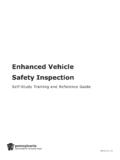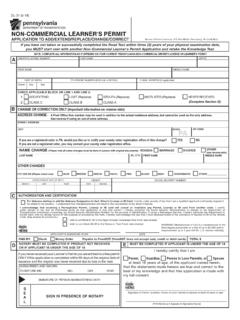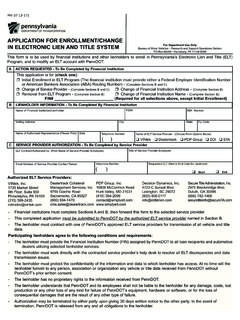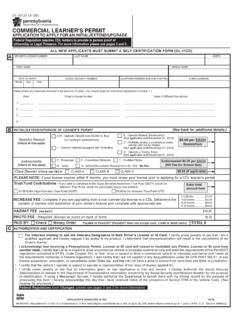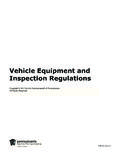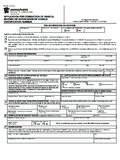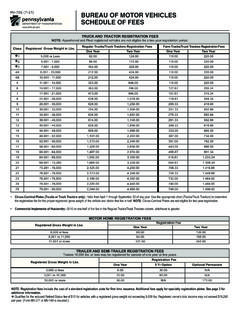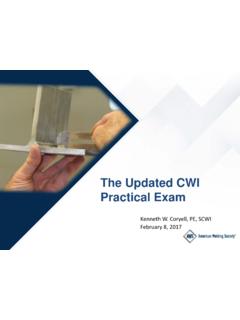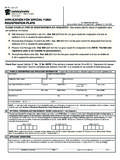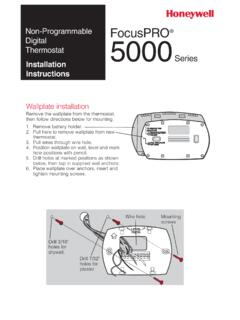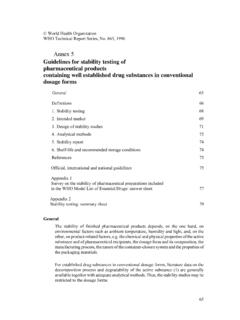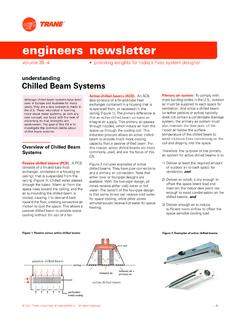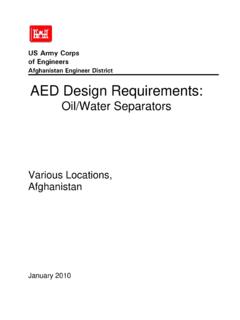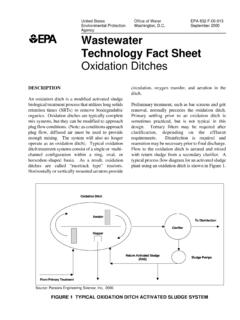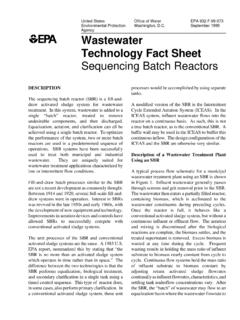Transcription of PUB 213 (3 21)
1 FAGANPALMANCROSSLEYPUB 213 (3-21)LARRYRYANBRIANPALMANFAGANCROSSLEYP ennsylvania has adopted the MUTCD as published by the FHWA with Pennsylvania specific modificationsthrough Title 67 PA Code, Chapter 212, Official Traffic Control Devices, which provides for TTC on all public roads in the 213 and the MUTCD apply to contractors utilities Federal, State, County, and Municipalgovernments and others performing construction, maintenance, emergency, permit work, utility work, or any other typeof work on highways or so closely adjacent to a highway that workers, equipment, or materials encroach on the roadway orinterfere with the normal movement of traffic. This includes special events that necessitate a need for of TTC devices while working on or near the roadway is a legal requirement per Pennsylvania Vehicle Code, Title 75, Section 6123(a).
2 Failure to utilize TTC devices properly is subject to fines in accordance with Title 75, Section 6123(d).Publication 213 PATA/GA drawings shall be regarded as minimum requirements. The TTC schemes shown inthis publication are consistent with the general provisions found in the most recent editions of Title 67 PA Code, Chapter 212, Official Traffic Control Devices and the MUTCD as issued by FHWA. Implementation should be based on common sense engineering judgment the speed and volume of traffic the duration of the operation the exposure to potential hazards the physical features of the highway including horizontal alignment, vertical alignment, and the presence of intersections and driveways and other important types of work listed in Title 67, Chapter are exempt from the requirements contained in this publication, however work must be accomplished in a manner that will provide an adequate degree of safety for workers and the work may be initiated without prior compliance with this publication and the MUTCD, provided safety measures and TTC are brought into compliance with this publication or the MUTCD as soon as possible.
3 Refer toTitle 67, Chapter for additional drawings present typical applications for a variety of situations commonly encountered. While not every situation is addressed, the information illustrated can generally be adapted to a broad range of conditions. In many instances, an appropriate TTC plan is achieved by combining features from various PATA/GA drawings. Elements of multiple PATAs may be combined without PennDOT DTU approval if minimum standards are satisfied. TTC setups that do not meet minimum standards require PennDOT DTU approval prior to drawings provide additional information to the TTC Consolidated Statutes Title 67 (Transportation)Pennsylvania Consolidated Statutes Title 75 (The Vehicle Code)PennDOT Publication 13M, Design Manual Part 2 Highway DesignPennDOT Publication 35, Qualified Products List for ConstructionPennDOT Publication 46, Traffic Engineering ManualPennDOT Publication 108, Sign Foreman's manualPennDOT Publication 111, Pavement Markings and Signing Standards TC 8600 and TC 8700 PennDOT Publication 149, Traffic Signal Design HandbookPennDOT Publication 234, Flagging HandbookPennDOT Publication 236, Handbook of Approved SignsPennDOT Publication 408, SpecificationsPennDOT Publication 445, Safety Policy HandbookInformation regarding TTC is found in.
4 Manual on Uniform Traffic Control Devices, Part 6 (Federal Highway Administration) PA Code Title 67 (Transportation), Chapter 212 (Official Traffic Control Devices) Department of Transportation, FHWA 2011 Traffic Sign Retroreflective Sheeting Identification Guide Quality Guidelines for Temporary Traffic Control Devices by American Traffic Safety Services Association (ATSSA)Reference MaterialsRYAN PALMAN LARRY FAGANBRIAN CROSSLEYT able of ContentsDefinitionsGeneral NotesSection A Worksite ProceduresItem DescriptionSection C Channelizing Devices and DelineationSection D SignsSection H Flashing Lights, Warning Lights, and Sequential Flashing Warning LightsSection I PedestriansReference ChartsGeneral ApplicationsSection E PCMS Trailer Placement, Visibility, Legibility, and Message ContentSection F TTC Setup and RemovalSymbolsPATA 200 Series conventional Highways Long Term Stationary OperationsPATA 300 Series conventional Highways Mobile OperationsPATA 400 Series Freeways & Expressways Short Term Stationary OperationsPATA 500 Series Freeways & Expressways Long Term Stationary OperationsPATA 600 Series Freeways & Expressways Mobile OperationsPATA 700 Series TTC Signal OperationsPATA 800 Series Hauling OperationsAppendix A TTC Sign Nomenclatures and SizesAppendix B Sign Sheeting Identification GuideAppendix D TTC Signal DocumentsAppendix E TMC Road Work Reporting FormAcronymsSection B Flagging OperationsSection G Vehicle/Equipment Parking and Material StoragePATA 100 Series conventional Highways Short Term Stationary OperationsAppendix C
5 TTC Device Quality GuidelinesIndexADT Average Daily TrafficAFAD Automated Flagger Assistance DeviceANSI American National Standards InstituteDTE District Traffic EngineerDTMC District Traffic Management CenterDTU District Traffic UnitGA General ApplicationLED Light Emitting DiodesFHWA Federal Highway AdministrationMUTCD Manual on Uniform Traffic Control DevicesPATA Pennsylvania Typical ApplicationPCMS Portable Changeable Message SignPennDOT Pennsylvania Department of TransportationPTC Pennsylvania Turnpike CommissionRCRS Road Condition Reporting SystemRTMC Regional Traffic Management CenterSV Shadow VehicleTMA Truck Mounted Attenuator / Trailer Mounted AttenuatorTMC Traffic Management CenterTPRS Temporary Portable Rumble StripsTTC Temporary Traffic ControlAcronymsActive Work Zone The portion of a work zone where construction, maintenance, or utility workers are on the roadway or on the shoulder of the highway, and workers are adjacent to an active travel lane.
6 Workers are not considered adjacent to an active travel lane if they are protected by a traffic barrier and no ingress or egress to the work zone exists through an opening in the traffic Area Area of a temporary traffic control zone comprised of the buffer space and the work space usually separated from traffic flow by channelizing devices or barrier located parallel to the travel Corner Sight Distance The maximum measured distance along a crossing highway which a driver stopped at a side road or driveway can continuously see another vehicle approaching. For the purpose of measuringthe available sight distance, the height of both the driver's eye and the approaching vehicle should be assumed to be 3' 6" above the road surface. In addition, the driver's eye should be assumed to be 10' back from the near edge of the highway or the near edge of the closest travel lane if parking is permitted along the Daily Traffic (ADT) Expressed as the number of vehicles per day using a given roadway.
7 ADTis the total volume of traffic during a number of whole days more than one day and less than one year divided by the numberof Space Area that separates traffic flow from the work space. Buffer spaces within the roadway shall remain clear of equipment, vehicles, workers, and materials. This requirement may include the adjacent shoulder as shown on the applicable PATA. The length of longitudinal buffer spaces (Distance E) may be increased for downgrades or other conditions that affect stopping sight distance. Longitudinal buffer space (Distance E) is measured upstream of the work space. Lateral buffer space is located between flowing traffic and the activity area. Width has no prescribed minimums or maximums and is to be determined on Device The function is to warn road users of conditions created by work activities inor near the roadway and to guide road Zone The total roadside border area, starting at the edge of traveled way, available for safe use by errant Condition (TTC Signals) A condition where driveways and/or side roads exist between the TTC signals.
8 Additional signal installations or flaggers are required to control traffic in additional to those shown on PATA 700 series Project Work performed as described in a Highway Any highway other than a freeway or expressway. conventional highways are further characterized as either Rural Highways or Urban Sight Distance See Available Corner Sight A term that refers to a location that is encountered by traffic subsequent to an upstream location as it flows in an "upstream to downstream" Flagger Flagger positioned on the downstream end of an operation. The downstream and upstream flaggers are labeled on General Application Detour Route System (EDRS) Pre established routes along conventional highways to guide traffic from one freeway interchange to the next interchange. Drivers may have to follow an emergency detour if a freeway is closed in at least one direction.
9 EDRS roadways are posted with trailblazer or route marker Work Emergencies may arise where it will be necessary to begin work even though all of the specific traffic control provisions may not be satisfied. In these cases all available safety measures shall be takenand the work zone shall be brought into compliance with this publication as soon as Judgment The evaluation of pertinent information, and the application of appropriate principles, provisions, and practices for the purpose of deciding upon the applicability, design, operation, or installationof a TTC device. Engineering judgment shall be exercised by an engineer, or by an individual working under the supervision of an engineer, through the application of procedures and criteria established by the A divided arterial highway for through traffic with partial control of access and generally with grade separations at major A limited access highway to which the only means of ingress and egress is by interchange (General Application) Drawings/Information within this Publication that is meant to be combinedwith or applied to the TTC The entire width between the boundary lines of every way publicly maintained when any partthereof is open to the use of the public for purposes of vehicular Offset (Lateral Clearance)
10 For TTC signs Area between the roadway/shoulder and nearest edge of a TTC sign or support. This area shall remain clear and available for vehicles utilizing the Term Stationary Operation Work that occupies a location for a period of more than 72 Operation An moving operation that proceeds downstream at least 100' every 15 minutes. Every component of the operation, excluding advanced warning signs and flagger locations, must proceed in the direction of normal traffic flow. The distance/time threshold must be met for the entire duration of the operation to utilize PATA 300 or 600 Series Lane More than one lane moving in the same Complex Condition (Temporary/Portable Traffic Signals) A condition where driveways and/or sideroads do not exist in the TTC zone utilizing temporary traffic signals.
